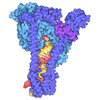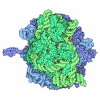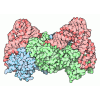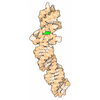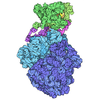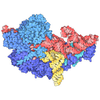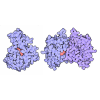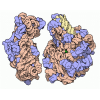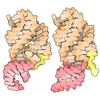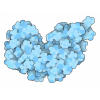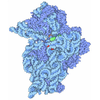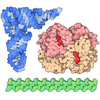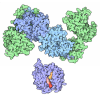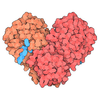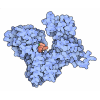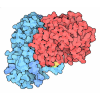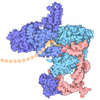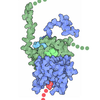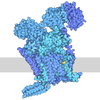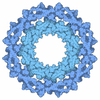+ データを開く
データを開く
- 基本情報
基本情報
| 登録情報 | データベース: PDB / ID: 7cyq | |||||||||||||||||||||||||||||||||
|---|---|---|---|---|---|---|---|---|---|---|---|---|---|---|---|---|---|---|---|---|---|---|---|---|---|---|---|---|---|---|---|---|---|---|
| タイトル | Cryo-EM structure of an extended SARS-CoV-2 replication and transcription complex reveals an intermediate state in cap synthesis | |||||||||||||||||||||||||||||||||
 要素 要素 |
| |||||||||||||||||||||||||||||||||
 キーワード キーワード | VIRAL PROTEIN/RNA / SARS-CoV-2 / Transcription and replication / nsp9 / nsp13 / nsp12-nsp7-nsp8 / VIRAL PROTEIN-RNA complex | |||||||||||||||||||||||||||||||||
| 機能・相同性 |  機能・相同性情報 機能・相同性情報protein guanylyltransferase activity / RNA endonuclease activity producing 3'-phosphomonoesters, hydrolytic mechanism / mRNA guanylyltransferase activity / 5'-3' RNA helicase activity / 付加脱離酵素(リアーゼ); P-Oリアーゼ類; - / Assembly of the SARS-CoV-2 Replication-Transcription Complex (RTC) / symbiont-mediated suppression of host cytoplasmic pattern recognition receptor signaling pathway via inhibition of TBK1 activity / Maturation of replicase proteins / TRAF3-dependent IRF activation pathway / ISG15-specific peptidase activity ...protein guanylyltransferase activity / RNA endonuclease activity producing 3'-phosphomonoesters, hydrolytic mechanism / mRNA guanylyltransferase activity / 5'-3' RNA helicase activity / 付加脱離酵素(リアーゼ); P-Oリアーゼ類; - / Assembly of the SARS-CoV-2 Replication-Transcription Complex (RTC) / symbiont-mediated suppression of host cytoplasmic pattern recognition receptor signaling pathway via inhibition of TBK1 activity / Maturation of replicase proteins / TRAF3-dependent IRF activation pathway / ISG15-specific peptidase activity / Transcription of SARS-CoV-2 sgRNAs / snRNP Assembly / Translation of Replicase and Assembly of the Replication Transcription Complex / Replication of the SARS-CoV-2 genome / 加水分解酵素; エステル加水分解酵素; 5'-リン酸モノエステル産生エキソリボヌクレアーゼ / double membrane vesicle viral factory outer membrane / host cell endoplasmic reticulum-Golgi intermediate compartment / SARS coronavirus main proteinase / 5'-3' DNA helicase activity / 3'-5'-RNA exonuclease activity / host cell endosome / symbiont-mediated degradation of host mRNA / mRNA guanylyltransferase / symbiont-mediated suppression of host ISG15-protein conjugation / G-quadruplex RNA binding / symbiont-mediated suppression of host toll-like receptor signaling pathway / symbiont-mediated suppression of host cytoplasmic pattern recognition receptor signaling pathway via inhibition of IRF3 activity / omega peptidase activity / mRNA (guanine-N7)-methyltransferase / methyltransferase cap1 / SARS-CoV-2 modulates host translation machinery / host cell Golgi apparatus / symbiont-mediated suppression of host NF-kappaB cascade / symbiont-mediated perturbation of host ubiquitin-like protein modification / DNA helicase / methyltransferase cap1 activity / ubiquitinyl hydrolase 1 / cysteine-type deubiquitinase activity / mRNA 5'-cap (guanine-N7-)-methyltransferase activity / 加水分解酵素; プロテアーゼ; ペプチド結合加水分解酵素; システインプロテアーゼ / single-stranded RNA binding / regulation of autophagy / viral protein processing / lyase activity / host cell perinuclear region of cytoplasm / host cell endoplasmic reticulum membrane / RNA helicase / symbiont-mediated suppression of host type I interferon-mediated signaling pathway / symbiont-mediated suppression of host gene expression / copper ion binding / viral translational frameshifting / symbiont-mediated activation of host autophagy / RNA-directed RNA polymerase / cysteine-type endopeptidase activity / viral RNA genome replication / RNA-directed RNA polymerase activity / DNA-templated transcription / lipid binding / host cell nucleus / SARS-CoV-2 activates/modulates innate and adaptive immune responses / ATP hydrolysis activity / proteolysis / RNA binding / zinc ion binding / ATP binding / membrane 類似検索 - 分子機能 | |||||||||||||||||||||||||||||||||
| 生物種 |  | |||||||||||||||||||||||||||||||||
| 手法 | 電子顕微鏡法 / 単粒子再構成法 / クライオ電子顕微鏡法 / 解像度: 2.83 Å | |||||||||||||||||||||||||||||||||
 データ登録者 データ登録者 | Yan, L. / Ge, J. / Zheng, L. / Zhang, Y. / Gao, Y. / Wang, T. / Wang, H. / Huang, Y. / Li, M. / Wang, Q. ...Yan, L. / Ge, J. / Zheng, L. / Zhang, Y. / Gao, Y. / Wang, T. / Wang, H. / Huang, Y. / Li, M. / Wang, Q. / Rao, Z. / Lou, Z. | |||||||||||||||||||||||||||||||||
| 資金援助 |  中国, 2件 中国, 2件
| |||||||||||||||||||||||||||||||||
 引用 引用 |  ジャーナル: Cell / 年: 2021 ジャーナル: Cell / 年: 2021タイトル: Cryo-EM Structure of an Extended SARS-CoV-2 Replication and Transcription Complex Reveals an Intermediate State in Cap Synthesis. 著者: Liming Yan / Ji Ge / Litao Zheng / Ying Zhang / Yan Gao / Tao Wang / Yucen Huang / Yunxiang Yang / Shan Gao / Mingyu Li / Zhenyu Liu / Haofeng Wang / Yingjian Li / Yu Chen / Luke W Guddat / ...著者: Liming Yan / Ji Ge / Litao Zheng / Ying Zhang / Yan Gao / Tao Wang / Yucen Huang / Yunxiang Yang / Shan Gao / Mingyu Li / Zhenyu Liu / Haofeng Wang / Yingjian Li / Yu Chen / Luke W Guddat / Quan Wang / Zihe Rao / Zhiyong Lou /   要旨: Transcription of SARS-CoV-2 mRNA requires sequential reactions facilitated by the replication and transcription complex (RTC). Here, we present a structural snapshot of SARS-CoV-2 RTC as it ...Transcription of SARS-CoV-2 mRNA requires sequential reactions facilitated by the replication and transcription complex (RTC). Here, we present a structural snapshot of SARS-CoV-2 RTC as it transitions toward cap structure synthesis. We determine the atomic cryo-EM structure of an extended RTC assembled by nsp7-nsp8-nsp12-nsp13-RNA and a single RNA-binding protein, nsp9. Nsp9 binds tightly to nsp12 (RdRp) NiRAN, allowing nsp9 N terminus inserting into the catalytic center of nsp12 NiRAN, which then inhibits activity. We also show that nsp12 NiRAN possesses guanylyltransferase activity, catalyzing the formation of cap core structure (GpppA). The orientation of nsp13 that anchors the 5' extension of template RNA shows a remarkable conformational shift, resulting in zinc finger 3 of its ZBD inserting into a minor groove of paired template-primer RNA. These results reason an intermediate state of RTC toward mRNA synthesis, pave a way to understand the RTC architecture, and provide a target for antiviral development. | |||||||||||||||||||||||||||||||||
| 履歴 |
|
- 構造の表示
構造の表示
| ムービー |
 ムービービューア ムービービューア |
|---|---|
| 構造ビューア | 分子:  Molmil Molmil Jmol/JSmol Jmol/JSmol |
- ダウンロードとリンク
ダウンロードとリンク
- ダウンロード
ダウンロード
| PDBx/mmCIF形式 |  7cyq.cif.gz 7cyq.cif.gz | 500.3 KB | 表示 |  PDBx/mmCIF形式 PDBx/mmCIF形式 |
|---|---|---|---|---|
| PDB形式 |  pdb7cyq.ent.gz pdb7cyq.ent.gz | 396.8 KB | 表示 |  PDB形式 PDB形式 |
| PDBx/mmJSON形式 |  7cyq.json.gz 7cyq.json.gz | ツリー表示 |  PDBx/mmJSON形式 PDBx/mmJSON形式 | |
| その他 |  その他のダウンロード その他のダウンロード |
-検証レポート
| 文書・要旨 |  7cyq_validation.pdf.gz 7cyq_validation.pdf.gz | 1 MB | 表示 |  wwPDB検証レポート wwPDB検証レポート |
|---|---|---|---|---|
| 文書・詳細版 |  7cyq_full_validation.pdf.gz 7cyq_full_validation.pdf.gz | 1.2 MB | 表示 | |
| XML形式データ |  7cyq_validation.xml.gz 7cyq_validation.xml.gz | 89 KB | 表示 | |
| CIF形式データ |  7cyq_validation.cif.gz 7cyq_validation.cif.gz | 136.4 KB | 表示 | |
| アーカイブディレクトリ |  https://data.pdbj.org/pub/pdb/validation_reports/cy/7cyq https://data.pdbj.org/pub/pdb/validation_reports/cy/7cyq ftp://data.pdbj.org/pub/pdb/validation_reports/cy/7cyq ftp://data.pdbj.org/pub/pdb/validation_reports/cy/7cyq | HTTPS FTP |
-関連構造データ
- リンク
リンク
- 集合体
集合体
| 登録構造単位 | 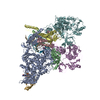
|
|---|---|
| 1 |
|
- 要素
要素
-タンパク質 , 2種, 3分子 AFE
| #1: タンパク質 | 分子量: 108162.461 Da / 分子数: 1 / 断片: UNP residues 4393-5324 / 由来タイプ: 組換発現 由来: (組換発現)  遺伝子: rep, 1a-1b / 発現宿主:  |
|---|---|
| #6: タンパク質 | 分子量: 66930.531 Da / 分子数: 2 / 断片: UNP residues 5325-5925 / 由来タイプ: 組換発現 由来: (組換発現)  遺伝子: rep, 1a-1b / 発現宿主:  |
-Non-structural protein ... , 3種, 4分子 BDCG
| #2: タンパク質 | 分子量: 21903.047 Da / 分子数: 2 / 断片: UNP residues 3943-4140 / 由来タイプ: 組換発現 由来: (組換発現)  遺伝子: rep, 1a-1b / 発現宿主:  #3: タンパク質 | | 分子量: 9248.804 Da / 分子数: 1 / 断片: UNP residues 3860-3942 / 由来タイプ: 組換発現 由来: (組換発現)  遺伝子: rep, 1a-1b / 発現宿主:  #7: タンパク質 | | 分子量: 12794.626 Da / 分子数: 1 / 断片: UNP residues 4141-4253 / 由来タイプ: 組換発現 由来: (組換発現)  遺伝子: rep, 1a-1b / 発現宿主:  |
|---|
-RNA鎖 , 2種, 2分子 IJ
| #4: RNA鎖 | 分子量: 10704.425 Da / 分子数: 1 / 由来タイプ: 合成 由来: (合成)  |
|---|---|
| #5: RNA鎖 | 分子量: 18808.152 Da / 分子数: 1 / 由来タイプ: 合成 由来: (合成)  |
-非ポリマー , 3種, 10分子 
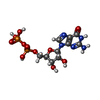



| #8: 化合物 | ChemComp-ZN / #9: 化合物 | ChemComp-GDP / | #10: 化合物 | ChemComp-MG / | |
|---|
-詳細
| 研究の焦点であるリガンドがあるか | Y |
|---|---|
| Has protein modification | N |
-実験情報
-実験
| 実験 | 手法: 電子顕微鏡法 |
|---|---|
| EM実験 | 試料の集合状態: PARTICLE / 3次元再構成法: 単粒子再構成法 |
- 試料調製
試料調製
| 構成要素 |
| ||||||||||||||||||||||||
|---|---|---|---|---|---|---|---|---|---|---|---|---|---|---|---|---|---|---|---|---|---|---|---|---|---|
| 由来(天然) |
| ||||||||||||||||||||||||
| 由来(組換発現) | 生物種:  | ||||||||||||||||||||||||
| 緩衝液 | pH: 7 | ||||||||||||||||||||||||
| 試料 | 包埋: NO / シャドウイング: NO / 染色: NO / 凍結: YES | ||||||||||||||||||||||||
| 急速凍結 | 凍結剤: ETHANE |
- 電子顕微鏡撮影
電子顕微鏡撮影
| 実験機器 |  モデル: Titan Krios / 画像提供: FEI Company |
|---|---|
| 顕微鏡 | モデル: FEI TITAN KRIOS |
| 電子銃 | 電子線源: OTHER / 加速電圧: 300 kV / 照射モード: OTHER |
| 電子レンズ | モード: BRIGHT FIELD |
| 撮影 | 電子線照射量: 60 e/Å2 フィルム・検出器のモデル: GATAN K2 QUANTUM (4k x 4k) |
- 解析
解析
| ソフトウェア | 名称: PHENIX / バージョン: 1.18rc3_3805: / 分類: 精密化 | ||||||||||||||||||||||||
|---|---|---|---|---|---|---|---|---|---|---|---|---|---|---|---|---|---|---|---|---|---|---|---|---|---|
| EMソフトウェア | 名称: PHENIX / カテゴリ: モデル精密化 | ||||||||||||||||||||||||
| CTF補正 | タイプ: PHASE FLIPPING AND AMPLITUDE CORRECTION | ||||||||||||||||||||||||
| 3次元再構成 | 解像度: 2.83 Å / 解像度の算出法: FSC 0.143 CUT-OFF / 粒子像の数: 529558 / 対称性のタイプ: POINT | ||||||||||||||||||||||||
| 原子モデル構築 | プロトコル: RIGID BODY FIT | ||||||||||||||||||||||||
| 拘束条件 |
|
 ムービー
ムービー コントローラー
コントローラー



 UCSF Chimera
UCSF Chimera
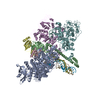

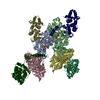


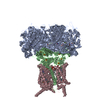

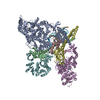
 PDBj
PDBj